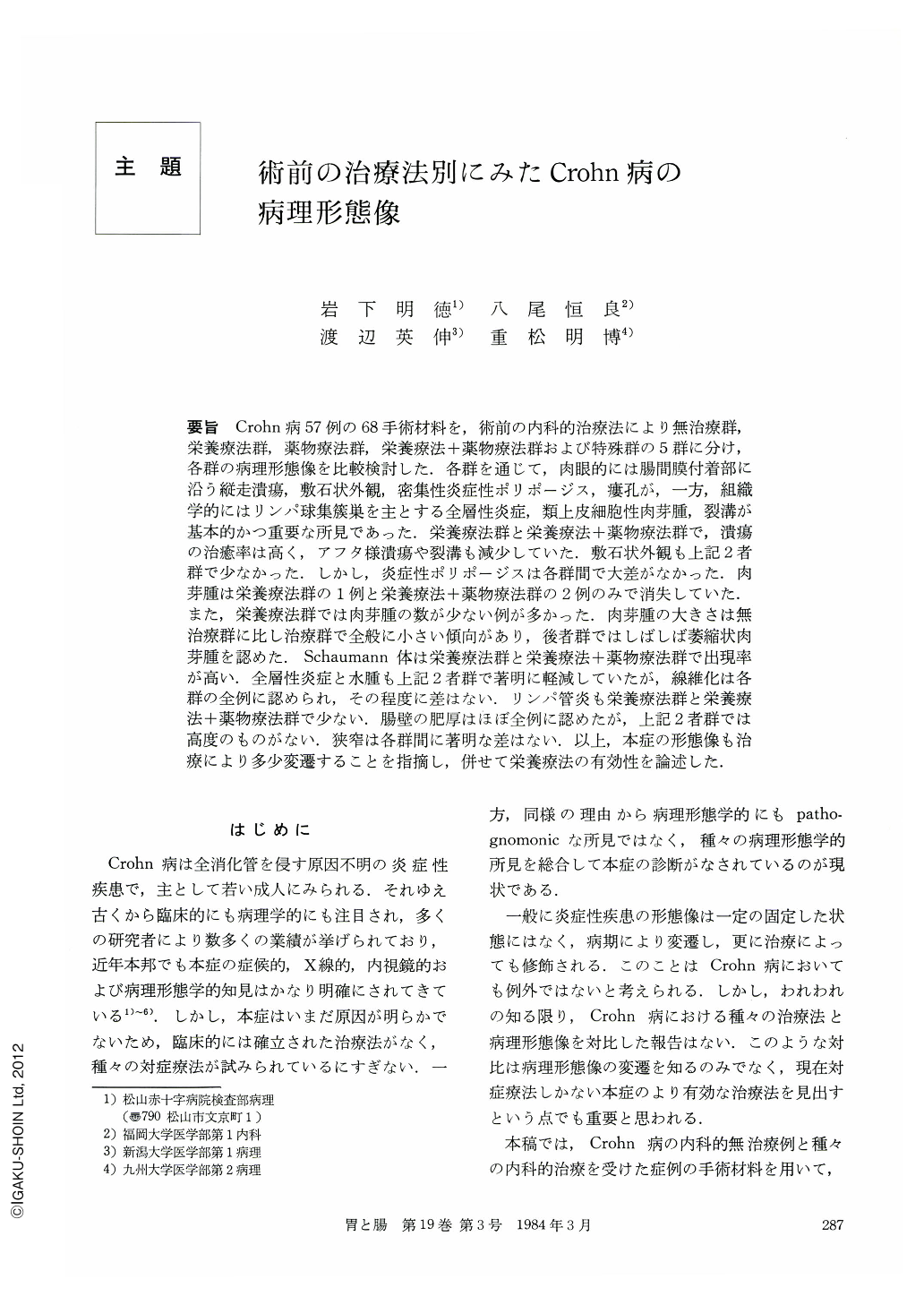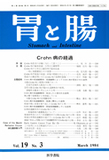Japanese
English
- 有料閲覧
- Abstract 文献概要
- 1ページ目 Look Inside
- サイト内被引用 Cited by
要旨 Crohn病57例の68手術材料を,術前の内科的治療法により無治療群,栄養療法群,薬物療法群,栄養療法+薬物療法群および特殊群の5群に分け,各群の病理形態像を比較検討した.各群を通じて,肉眼的には腸間膜付着部に沿う縦走潰瘍,敷石状外観,密集性炎症性ポリポージス,瘻孔が,一方,組織学的にはリンパ球集蔟巣を主とする全層性炎症,類上皮細胞性肉芽腫,裂溝が基本的かつ重要な所見であった.栄養療法群と栄養療法+薬物療法群で,潰瘍の治癒率は高く,アフタ様潰瘍や裂溝も減少していた.敷石状外観も上記2者群で少なかった.しかし,炎症性ポリポージスは各群間で大差がなかった.肉芽腫は栄養療法群の1例と栄養療法+薬物療法群の2例のみで消失していた.また,栄養療法群では肉芽腫の数が少ない例が多かった.肉芽腫の大きさは無治療群に比し治療群で全般に小さい傾向があり,後者群ではしばしば萎縮状肉芽腫を認めた.Schaumann体は栄養療法群と栄養療法+薬物療法群で出現率が高い.全層性炎症と水腫も上記2者群で著明に軽減していたが,線維化は各群の全例に認められ,その程度に差はない.リンパ管炎も栄養療法群と栄養療法+薬物療法群で少ない.腸壁の肥厚はほぼ全例に認めたが,上記2者群では高度のものがない.狭窄は各群間に著明な差はない.以上,本症の形態像も治療により多少変遷することを指摘し,併せて栄養療法の有効性を論述した.
Fifty-seven cases with Crohn's disease were studied on 68 surgical specimens. Those cases were divided into five groups according to the mode of preoperative treatment; i) cases in whom the diagnosis of Crohn's disease had not been made before operation and any treatment had not been given (group of no treatment), ii) cases in whom IVH or ED had been given (group of nutritional treatment), iii) cases who had taken a treatment with steroid, sulfasalazine or metronidazole (group of medication), iv) cases who had taken a treatment of both nutritional and medical treatment (group of combined treatment), v) cases in whom nutritional or combined treatment had been discontinued one to five months prior to operation (group of other treatment). Both macroscopic and histopathologic features were comparatively studied among five groups. The results obtained were as follows:
1) The principal and important pathological findings of all groups were macroscopically, (1) longitudinal ulcer along the mesenteric attachment, (2) cobblestone appearance, (3) dense inflammatory polyposis and (4) fistulas. Microscopically those were, (1) transmural inflammation mainly composed of lymphocytic aggregates, (2) non-caseating epitheliod cell granulomas and (3) fissures.
2) The ulcers were completely or almost healed in 69.2% in group of nutritional treatment, in 62.5% in group of combined treatment and in 38.5% in group of medication. There was no case in group of no treatment in whom complete healing of ulcers were recognized. Aphthoid ulcers were found in as many as 75.9% in group of no treatment and in 61.5% in group of medication. However, on the contrary, only 7.7% and 25% of cases had aphthoid ulcers in group of nutritional treatment and in that of combined treatment, respectively. Same tendency was obtained in frequency of fissures, which had been found in 96.6% and 92.3% in groups of no treatment and medication, respectively, as opposed to groups of nutritional and combined treatment who had fissures in only 53.8% and 50% respectively.
(3) Cobblestone appearance was found in 55.2% in group of no treatment and in 62.5% in that of medication. In groups of nutritional and combined treatment, however, the frequency of cobblestone appearance was as low as 15.4% and 37.5%. The frequency of inflammatory polyposis was the lowest in group of no treatment (55.2%) and the highest in that of medication (76.9%). There was no distinct difference in frequency of inflammatory polyposis among other three groups (about 60%).
(4) Granulomas were recognized in all the cases except for one with nutritional treatment and two with combined treatment. Many cases of group of nutritional treatment had fewer granulomas as compared to those of other groups. The size of granulomas tended to be smaller in cases with treatment in comparison with those without treatment, and atrophic granulomas were more frequently found in those with treatment. Schaumann's body was more often recognized in group of nutritional treatment (30.8%) and that of combined treatment (25%) than in that of medication (15%) and of no treatment (10.3%).
5) The severity of transmural inflammation and edema was remarkably reduced in groups of nutritional treatment and combined treatment. Fibrosis was found in all groups and there was no significant difference among those groups.
(6) The frequency of lymphangitis was much lower in groups of nutritional treatment (23.1%) and combined treatment (25%) as compared to those of no treatment (58.6%), medication (69.2%) and other treatment (80%).
(7) Variable degrees of mural thickening was found in all the cases except for one with combined treatment. However, there was no case with nutritional or combined treatment who revealed marked mural thickening. There was no distinct difference among five groups in the frequency and degree of stenosis.
(8) From these results it was pointed out that pathological features undergo changes to some extent. In addition, therapeutic effectiveness of IVH and ED was shown.

Copyright © 1984, Igaku-Shoin Ltd. All rights reserved.


